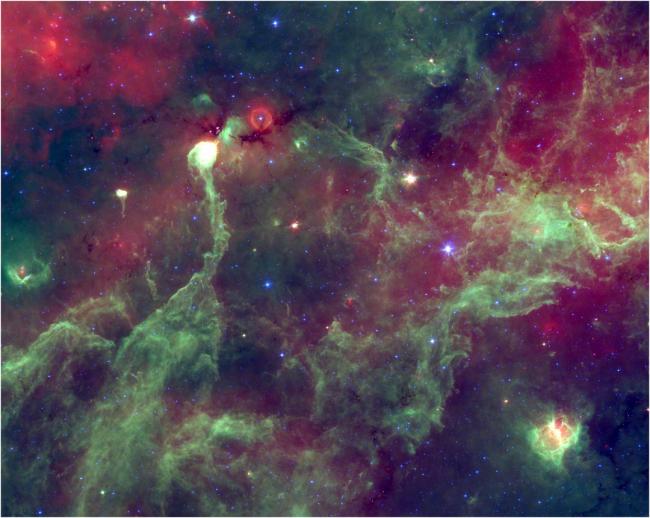
An infrared image of a portion of a giant complex of massive star formation in our Milky Way galaxy (known as Cygnus-X), as seen by the Spitzer Space Telescope. Astronomers using the Submillimeter Array have been able to study even more dramatic regions of massive star formation (indeed, the most luminous known) in distant galaxies.
Although many of the details about star formation are vigorously debated, the general principles are reasonably well understood. Stars form as the gas and dust in a molecular cloud coalesces until, under the influence of gravity, clumps develop dense enough to become stars. Clusters of young stars typically contain many massive, hot members that shine brightly; the Pleiades is an example of a young cluster with hot young stars. The question arises as to what might happen in extreme cases, such as might exist when galaxies formed in the early universe. If many hot young clusters develop in small regions, their radiation pressure alone could be intense enough to overpower gravity, repel infalling material,and limit the formation of more stars. This so-called Eddington limit, named after the 20th century astronomer who realized that radiation could in extreme instances balance gravity, would occur (at least for this specific example of starbursts; it can also happen in other situations) only in cases much more dramatic than anything known in our own galaxy. Until now it was just a theoretical curiosity.
A group of CfA astronomers, Giovanni Fazio, Matt Ashby, Francesco Civano, Martin Elvis, Mark Gurwell, Jia-Sheng Huang, Glen Petitpas, and David Wilner, along with the team leader Josh Younger (a recent student at CfA) and four colleagues, have now found what appear to be two examples of starburst activity in galaxies so dramatic that the Eddington limit for starbursts has been reached.
The scientists used the Submillimeter Array (SMA) to observe two distant galaxies that were known to be bright -- each shining with the light of more than about ten trillion suns. What had not been previously known was the size of the brightest regions in these objects. The SMA's
uniquely high spatial resolution in the submillimeter allowed the team to measure comparatively small structures in these galaxies. They found that the bulk of the radiation was actually confined to giant regions approximately 20,000 light-years across - sizes that seem large by earth standards, but tiny if they have to contain the equivalent of ten trillion suns. In fact, the astronomers conclude that the Eddington limit for star formation could be operative there, under some reasonable assumptions about the geometry and local conditions. The results suggest that these super-starbursts were produced by galaxy-galaxy collisions, and shed light not only on star formation in early galaxies, but also on the physical principles at work in (admittedly extreme) stellar nurseries.